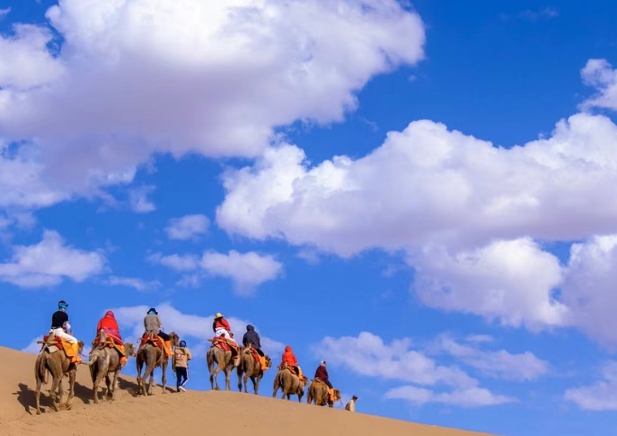Connectivity revives ancient Silk Road in China's Gansu Province

Upon her arrival at Mogao Caves in Dunhuang City, Xinhua journalist Daria Vorobeva was impressed not only by the delicate millennial-old Buddhist painting, but also by the city's commitment to reviving the cultural diversity of this UNESCO World Heritage and sharing it with the world.
"One can find traces of various cultures; it's so rich and fascinating," Vorobeva said.
In 126 B.C., following the return of the royal emissary Zhang Qian from his journey westward from Chang'an, the capital of the Han Dynasty (202 B.C.-220 A.D.), the corridor for commercial and cultural exchanges across Asia and Europe flourished, which has later been known as the Silk Road.
Since then, a continuous flow of merchants, envoys, and monks from around the world have traversed the Silk Road, coming to China for commercial trade, cultural communication, and exploration.
In the contemporary era, the China-proposed Belt and Road Initiative (BRI) revives the spirit of the Silk Road and injects new vitality into greater connectivity with countries and regions participating in the initiative.
Northwest China's Gansu Province was an important passage along the Silk Road. Its time-honored cultural relics and ancient architecture, scattered like pearls along the route, showcase its historical prosperity.
In museums, artifacts on display include not only silk from China but also artifacts from India, brocades from Persia, glassware from Rome, as well as currency from the Eastern Roman Empire and Sassanid Persia.
Unearthed sculptures and brick paintings also depict the figures of ancient Sogdians, Persians, and Greeks traveling along the Silk Road.
Among these, the millennium-old Mogao Caves in Gansu's Dunhuang City, a UNESCO World Heritage site boasting rich collections of Buddhist artworks, represent the pinnacle of civilization diversity.
According to Bakyt Amanbayeva, chief researcher at the National Academy of Sciences of the Kyrgyz Republic, Dunhuang in China preserves a fascinating Buddhist culture that was introduced to the northern regions of Kyrgyzstan in the early Middle Ages via the Silk Road, evidenced by the relics of two Buddhist temples at the City Site of Ak-Beshim, 50 km east of Bishkek, one of the largest medieval archaeology site in Central Asia.
"Human civilizations will become richer and more diverse through exchanges and mutual learning, contributing to the development of a harmonious world built on mutual understanding," said Zhao Shengliang, director of the Dunhuang Academy.
Nowadays, inspired by the Silk Road spirit, the BRI is producing positive impacts on trade and people-to-people exchanges among partners.
In October 2023, thanks to improved connectivity among BRI partner countries and regions, Russian flower trader Ageev Rinad for the first time in his decade-long career brought fresh-cut roses from Linxia Hui Autonomous Prefecture of Gansu to Russia with overland transportation.
The roses rode a cold-chain truck, passing through the Alataw Pass in the northwestern Xinjiang Uygur Autonomous Region before entering Kazakhstan and landing in vases of families in Moscow.
Today, tropical fruits and seafood from Southeast Asia, mineral products from Central Asia, and timber from Europe can be imported into Gansu. Conversely, Gansu's apples, onions, asbestos, and industrial products are exported to Central Asia, South Asia, and ASEAN countries.
In 2014, a joint application by China, Kazakhstan, and Kyrgyzstan led to the recognition of "the Silk Roads: the Routes Network of Chang'an-Tianshan Corridor" as a UNESCO World Heritage Site.
In recent years, experts from the Dunhuang Academy have visited countries along the Silk Road such as Iran, Afghanistan, and Uzbekistan for research and exchanges. Joint archaeological research, technology sharing, and knowledge communication for the ancient heritage have renewed cultural bonds among these countries nearly 2,000 years later.
Amanbayeva said that topics related to the Silk Road are popular among Kyrgyzstanis. Like many of her fellow citizens, she hopes for long-term cooperation with China on cultural relics protection.
Editor:伏娅敏
